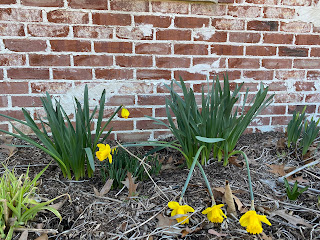Sunday, February 26, 2023
Spring in our garden came early this year; about 4 weeks early. February looks to end as the second warmest February on record. Daffodils and forsythias are in full bloom now with buds on the Bradford pear and redbud trees. Now is a great time to start sowing seeds outdoors for the spring edible garden.
When forsythias bloom, it is time to apply corn gluten for weed suppression in the garden and yard. Corn gluten keeps seeds from sprouting and provides nitrogen. It will also keep grass seed or garden seed from sprouting so use only where you don't want seeds to come up.
In the edible garden, onions, celery, horseradish, carrots, garlic, and garlic chives are all popping up in the garden bed. Overwintering celery, sorrel, lettuce, arugula, cress, sprouting broccoli, Austrian peas and pok choi are growing again. Chickweed is flowering. The garden is giving greens for fresh picked salads.
Cool season crop transplants are not at the local nurseries and big box stores yet. Likely be a few more weeks before they come in. Now is a great time to get the garden beds ready for March transplants by doing a soil test, adding compost and mulching your beds.
 |
| Overwintering cabbage and broccoli |
I have also planted snow pea, lettuce, Chinese cabbage, sweet mustard greens, orach and spinach seeds to keep the salad greens going through June. Orach, sweet mustard greens and Hilton Chinese cabbage leaves stay sweet all the way through summer. All love the cool weather so now is a great time to get your seeds planted outdoors. I'll keep sowing some lettuce seeds about every 3 weeks to keep salads going all summer.
The I sowed cilantro, dill, parsley, rosemary and basil in my pots, too. It was likely too early for the basil as it will turn black when temps get below freezing. I can use my portable greenhouse cover to keep it protected after it has sprouted. Our last frost is typically in early April.
Here is the list of edibles I have planted so far outdoors, all in pots:
Snow peas-Avalanche (30" vine), Oregon Sugar Pod II (28" vine), Purple Snow Pea (24" vine)
Spinach-Giant Winter and Galilee. Galilee is very heat tolerant
Lettuce-Royal Oak Leaf, Oak Leaf, Red Sails, Forellenschluss, Green Salad Bowl, Butter King, Bronze Beauty, Solar Flare, Lunix
Chinese Cabbage-Hilton, Golden Beauty and Scarlette F1
Chard-Verde de Taglio and Perpetual Spinach
Orach-Aurora mixed colors
Radish-Dragon's Tail (grown for seed pods not the root)
Herbs-Rosemary, Flat Leaf Parsley, Dill, Sweet Basil, Chives, Cilantro
I have only started a few edibles indoors-Orange Hat Micro tomato and Jigsaw pepper. I hope both of these can be grown indoors year round.
There are more seeds to start outdoors when the temperatures are warmer like beans, squash, cucumber and peppers. I haven't decided if I am going to start my tomatoes, eggplant and amaranth indoors or outdoors in pots and then transplant into their permanent spots after they have sprouted and grown a bit. I have another 4 weeks to decide.














